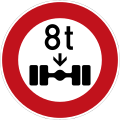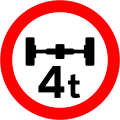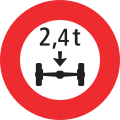Key:maxaxleload
Jump to navigation
Jump to search
 |
| Description |
|---|
| The legal maximum axleload in metric tonnes. |
| Group: restrictions |
| Used on these elements |
| Useful combination |
|
| See also |
|
| Status: in use |
| Tools for this tag |
|
maxaxleload indicates the legal load weight limit per axle, when the weight limit is given as a formula based on the number of axles.
If no unit is included, the value is assumed to be in metric tonnes (t, 1000 kg). In the United States, the weight given on signs is either in short tons (abbreviated as either "tons" or "T") or pounds (abbreviated "lbs"). You must explicitly specify the unit if it is not in metric tonnes.
If the sign lists a specific weight for each number of axles, then use maxweight:conditional=* with the vehicle property axles.
Examples
with signs around the world:
-
 New Zealand:
New Zealand:
maxaxleload=4.6
maxweight=9.2
maxweight:conditional=9.2 @ (axles=2); 13.8 @ (axles=3); 18.2 @ (axles=4); 22.4 @ (axles=5); 25.2 @ (axles=6); 28 @ (axles=7); 30.8 @ (axles=8); 35 @ (axles=9)[2]
maxspeed:hgv=50
United States
-
 Texas:
Texas:
maxweight:hgv=25100 lbs
maxweight:hgv:conditional=38200 lbs @ (trailer)
maxweight:hgv_articulated=38200 lbs
maxaxleload=10400 lbs
maxbogieweight=16200 lbs
-
United States, more widely described at maxweight page:
maxweight=8 st
maxweight:hgv_articulated=12 st
maxweight:hgv:conditional=16 st @ (trailer)
(specify unit as short tons)
References
- ↑ “Farm Guide: Farm Equipment on the Highway” (PDF). Ontario Ministry of Transportation. October 30, 2017. p. 31. Retrieved July 4, 2019.
- ↑ Each Class I weight for an axle configuration is multiplied by 0.7. For 2-axle and 3-axle vehicles, the maximum axle load (4600 kg) limits the gross weight further below 70% of Class I.


![Canada ( Ontario): maxaxleload=8.2[1] maxaxleload:conditional=5.5 @ (bogie)](https://upload.wikimedia.org/wikipedia/commons/thumb/c/c9/CA-ON_road_sign_Rb-077_%28E%29.svg/120px-CA-ON_road_sign_Rb-077_%28E%29.svg.png)






















